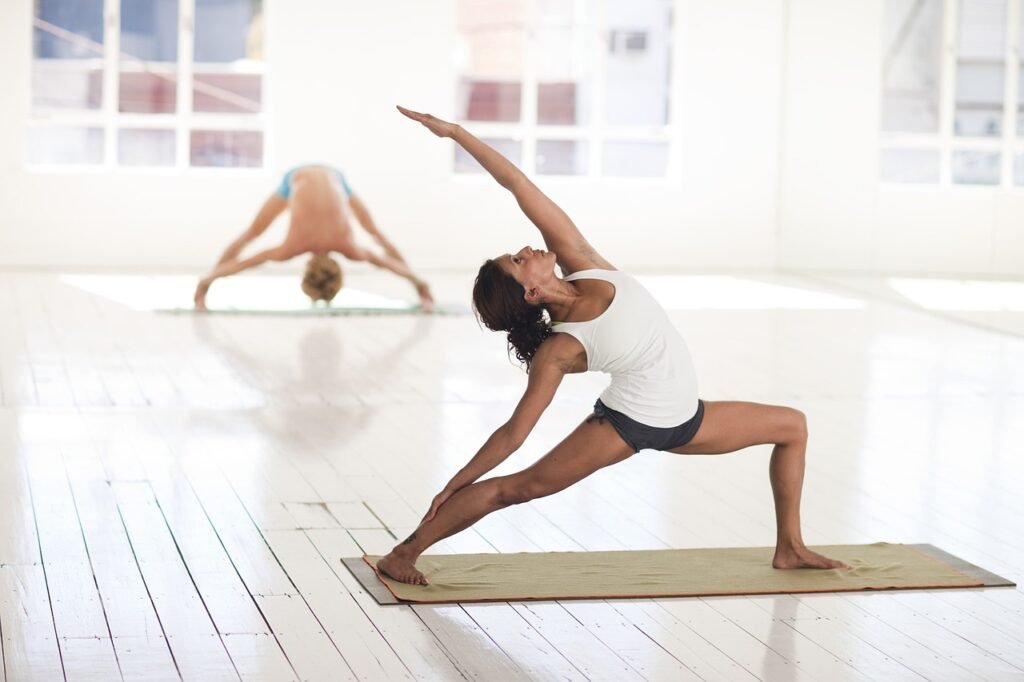
Are you looking to improve your strength and agility without having to leave the comfort of your own home? Look no further! In this article, we will introduce you to the exciting world of plyometric exercises. These high-intensity workouts involve explosive movements that can enhance your power, speed, and overall athletic performance. Whether you’re a seasoned athlete or just starting your fitness journey, plyometric exercises can be easily incorporated into your home workout routine. Get ready to jump, squat, and lunge your way to a fitter, faster, and more agile you!”

This image is property of pixabay.com.
Find more product like these on Amazon!
Introduction
If you’re looking to improve your overall strength, power, and agility from the comfort of your home, then plyometric exercises are the perfect solution for you. Plyometric exercises, also known as jump training, involve explosive movements that engage your muscles to improve their power and agility. In addition to enhancing your physical fitness, plyometric exercises also provide cardiovascular benefits, making it a comprehensive workout option. In this article, we will explore the various benefits of plyometric exercises, safety precautions to keep in mind, the equipment needed for plyometric workouts at home, different types of exercises to try, how to create a workout routine, and some tips for effective plyometric training. So get ready to jump into a world of fitness and discover the incredible potential of plyometric exercises!
Benefits of Plyometric Exercises
Improves Strength
One of the key benefits of incorporating plyometric exercises into your workout routine is the significant improvement in strength. As you perform explosive movements like jumping and bounding, your muscles are forced to work against resistance, leading to greater muscle activation and development. Plyometric exercises primarily target the fast-twitch muscle fibers, which are responsible for generating strength and power. By consistently challenging these muscles with plyometric exercises, you can effectively increase your overall strength.
Increases Power
Plyometric exercises are renowned for their ability to enhance explosive power. The rapid muscle contractions involved in plyometric movements help to develop the muscles’ contractile force, enabling you to generate more power in a shorter amount of time. This increase in power is beneficial not only for athletes looking to improve their performance in sports that require explosive movements, like basketball or soccer, but also for everyday activities that require quick bursts of energy, such as sprinting or lifting heavy objects.
Enhances Agility
Agility is the ability to quickly change direction and move with precision and speed. Plyometric exercises are highly effective in improving agility as they require rapid adjustments in body position and quick movements. By practicing plyometrics, you can enhance your proprioception (the body’s awareness of its position in space) and improve your ability to react quickly to different situations. This can be particularly useful in sports that require quick changes in direction, such as tennis or martial arts.
Boosts Cardiovascular Fitness
In addition to the muscular benefits, plyometric exercises also provide a great cardiovascular workout. The high-intensity nature of plyometric movements raises your heart rate and promotes increased blood flow throughout your body. This not only improves your cardiovascular endurance but also helps to burn calories and increase overall stamina. By incorporating plyometric exercises into your routine, you can achieve a comprehensive cardiovascular workout without the need for traditional cardio exercises like running or cycling.
Safety Precautions
While plyometric exercises can be highly beneficial, it is essential to prioritize safety to avoid any potential injuries. Here are some important safety precautions to keep in mind before starting your plyometric workouts:
Consult with a healthcare professional
Before beginning any new exercise program, it is always a good idea to consult with a healthcare professional, especially if you have any pre-existing medical conditions or injuries. They can provide personalized guidance based on your individual needs and help ensure that plyometric exercises are safe for you.
Warm-up properly
Proper warm-up is crucial when it comes to plyometric exercises. Before jumping into high-intensity movements, it’s important to prepare your muscles and joints by engaging in dynamic stretching exercises and light cardio. This helps to increase blood flow and temperature in your muscles, reducing the risk of injury.
Use proper form
Maintaining proper form is essential to prevent injury and maximize the effectiveness of plyometric exercises. It’s crucial to focus on proper alignment, engage your core, and land softly to minimize impact on your joints. If you’re unsure about the correct form, consider working with a qualified trainer or watching instructional videos that demonstrate the proper technique.
Assess your fitness level
Plyometric exercises can be intense and put a considerable amount of stress on your muscles and joints. Before incorporating plyometrics into your routine, assess your current fitness level and make sure you have a solid foundation of strength and stability. Starting with low-impact exercises and gradually increasing the intensity will help prevent overexertion and reduce the risk of injury.
Equipment for Plyometric Exercises at Home
While plyometric exercises can be performed without any equipment, using certain tools can enhance your workout experience and provide additional resistance. Here are some recommended pieces of equipment for plyometric exercises at home:
Jump box
A jump box is a versatile and essential piece of equipment for plyometric workouts. It allows you to perform exercises like box jumps, step-ups, and lateral jumps, providing a stable platform to land on and an adjustable height to suit your fitness level. Jump boxes are typically made of sturdy materials like wood or metal and come in various sizes.
Resistance bands
Resistance bands are lightweight and portable, making them perfect for home workouts. They provide external resistance and can be used to intensify plyometric exercises such as jump squats or power push-ups. Resistance bands come in different strengths, allowing you to adjust the level of resistance based on your fitness level.
Medicine ball
Medicine balls are weighted balls that can be used for various plyometric exercises, including chest passes, overhead slams, and rotational throws. They are available in different weights, and their soft exterior makes them safe to use indoors. Medicine balls add an additional challenge to plyometric exercises by adding resistance and requiring greater muscle engagement.

This image is property of pixabay.com.
Basic Plyometric Exercises
Now that you understand the benefits of plyometric exercises and have the necessary equipment, let’s dive into some basic plyometric exercises that you can easily perform at home. These exercises will target different muscle groups and help you build a foundation of strength and power. Remember to warm up properly and focus on maintaining proper form throughout each exercise.
Jump squats
Jump squats are a fantastic plyometric exercise that targets your lower body, specifically your quadriceps, hamstrings, and glutes. To perform a jump squat, start in a standing position with your feet shoulder-width apart. Lower yourself into a squat position, keeping your knees behind your toes and your chest lifted. From here, explosively jump up into the air, extending your hips and knees fully. Land softly back into the squat position and repeat for the desired number of repetitions.
Box jumps
Box jumps are a classic plyometric exercise that engages your lower body and helps develop explosive power. To perform a box jump, start by standing in front of a sturdy jump box or platform. Begin with your feet shoulder-width apart and lower yourself into a quarter-squat position. From here, explosively jump onto the top of the box, extending your hips and knees fully. Step back down from the box and repeat the exercise for the desired number of repetitions.
Lateral jumps
Lateral jumps are a dynamic plyometric exercise that targets your lower body and improves your lateral power and agility. To perform a lateral jump, start in a standing position with your feet shoulder-width apart. From here, jump laterally to one side, pushing off with your outside foot and landing softly on the opposite side. Immediately jump back to the starting side and repeat the movement for the desired number of repetitions.
Power push-ups
Power push-ups are a challenging plyometric exercise that engages your chest, shoulders, and triceps, while also increasing upper body explosiveness. To perform a power push-up, start in a regular push-up position with your hands slightly wider than shoulder-width apart. Lower yourself into a push-up, and as you push back up, explosively push your hands off the ground, allowing your upper body to leave the ground. Land softly back into the starting position and repeat for the desired number of repetitions.
Advanced Plyometric Exercises
Once you have mastered the basic plyometric exercises, you can progress to more advanced variations to further challenge yourself and continue improving your strength and power. These exercises require a higher degree of explosiveness and coordination, so make sure you have a solid foundation before attempting them.
Plyo push-ups
Plyo push-ups are a more advanced variation of the power push-up. To perform a plyo push-up, start in a regular push-up position with your hands slightly wider than shoulder-width apart. Lower yourself into a push-up and as you push back up, explosively push your hands off the ground, allowing your upper body to leave the ground. While in the air, quickly clap your hands together, then land softly back into the starting position. Repeat for the desired number of repetitions.
Depth jumps
Depth jumps are an advanced plyometric exercise that focuses on explosive lower body power. To perform a depth jump, start by standing on a sturdy elevated platform. Step off the platform, landing with both feet at the same time onto the ground. As soon as your feet touch the ground, immediately explode into a vertical jump, reaching as high as you can. Land softly and repeat the exercise for the desired number of repetitions.
Burpees
Burpees are a full-body plyometric exercise that targets multiple muscle groups and provides a cardiovascular challenge. To perform a burpee, start in a standing position with your feet shoulder-width apart. Lower yourself into a squat position, place your hands on the ground in front of you, and kick your feet back into a push-up position. Perform a push-up, then jump your feet forward into a squat position. Finally, explosively jump up into the air, reaching your hands overhead. Land softly and immediately move into the next repetition.
Tuck jumps
Tuck jumps are an explosive plyometric exercise that targets your lower body and core muscles. To perform a tuck jump, start in a standing position with your feet hip-width apart. From here, explosively jump up into the air, bringing both knees towards your chest in a tuck position. Extend your legs back out before landing softly on the ground. Repeat for the desired number of repetitions.

This image is property of pixabay.com.
Creating a Plyometric Workout Routine
To make the most of your plyometric training, it’s important to create a structured workout routine that targets different muscle groups and progressively increases in intensity. Here are some steps to help you create an effective plyometric workout routine:
Set clear goals
Before starting your plyometric training, define your specific goals. Do you want to improve strength, increase power, or boost agility? Identifying your goals will help you to choose the most appropriate exercises and track your progress effectively.
Choose exercises targeting different muscle groups
To ensure a well-rounded workout, include exercises that target different muscle groups. This will help to prevent muscle imbalances and promote overall strength and power development. Incorporate both lower body and upper body plyometric exercises for a comprehensive routine.
Determine workout frequency
Plan how often you will perform your plyometric workouts. It’s important to give your muscles enough time to recover between sessions to avoid overtraining and reduce the risk of injury. Aim for two to three sessions per week with at least one day of rest in between each workout.
Track your progress
Keep a record of your workouts to track your progress over time. Note the exercises performed, the number of sets and repetitions, and any modifications or progressions made. This will help you stay motivated and ensure that you are consistently challenging yourself.
Tips for Effective Plyometric Training
To maximize the effectiveness and safety of your plyometric training, here are some additional tips to keep in mind:
Focus on proper landing technique
Land softly and quietly after each jump, focusing on absorbing the impact through your muscles rather than your joints. This will help to reduce the risk of injury and ensure that you are performing the exercises with correct form.
Start with low-intensity exercises
If you are new to plyometric training, start with low-intensity exercises and gradually progress to more advanced movements. This will allow your body to adapt to the demands of plyometrics and reduce the risk of overexertion or injury.
Gradually increase intensity and volume
As you become more comfortable with the exercises, gradually increase the intensity and volume of your plyometric workouts. This can be achieved by adding more sets and repetitions, increasing the height or distance of jumps, or incorporating more challenging variations of the exercises.
Listen to your body
Pay attention to your body and any signs of fatigue or discomfort. It’s important to give yourself enough rest and recovery time to prevent overtraining and avoid potential injuries. If you experience pain or prolonged discomfort, consult with a healthcare professional.
Sample Plyometric Workout
Here’s a sample plyometric workout routine to get you started. Remember to warm up properly before starting and adjust the intensity and duration based on your fitness level:
Warm-up: 5-10 minutes
- Jogging in place
- Arm circles
- Leg swings
- High knees
- Jumping jacks
Exercises: 3 sets of 10 reps each
- Jump squats
- Box jumps
- Lateral jumps
- Power push-ups
Cool-down: 5-10 minutes
- Static stretching
- Deep breathing exercises
Conclusion
Plyometric exercises offer a fun and effective way to improve your strength, power, agility, and cardiovascular fitness from the comfort of your home. By incorporating plyometric exercises into your workout routine and following the safety precautions, you can reap the numerous benefits of this high-intensity training. Whether you are a seasoned athlete looking to enhance your performance or a fitness enthusiast seeking a challenging workout, plyometric exercises are a fantastic option. So get ready to jump-start your fitness journey and discover the incredible potential of plyometrics!

